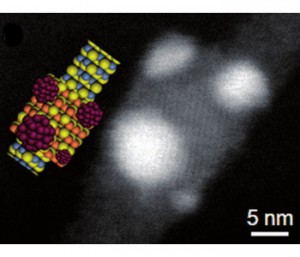
 |
To address this a team led by Prof. Shu-Hong Yu and Prof. Jun Jiang at the Hefei National Laboratory for Physical Sciences at Micrscale (HFNL), Department of Chemistry, University of Science and Technology of China (USTC), and Prof. Xin-Chen Wang at Fuzhou University, has recently demonstrated the synthesis of unique one-dimensional (1D) binary -[S1-S2]-S1-[S1-S2]-S1- and ternary -[S1-(S2/M)]-S1-[S1-(S2/M)]-S1- heteronanorods with segmented node sheaths S2 decorated by M (S1 = ZnS; S2 = CdS; M = Au, Pd, Pt) through the colloidal technique. As verified by first-principles simulations, the conversion from type-I ZnS-CdS heterojunction to type-II ZnS-(CdS/metal) ensures well-steered collections of photo-generated electrons at the exposed ZnS nanorod stem and metal nanoparticles while holes at the CdS node sheaths, leading to substantially improved photocatalytic hydrogen evolution performance.
The ternary ZnS-(CdS/metal) hybrids were prepared by the post-synthetic modification of binary multi-node sheath ZnS-CdS heteronanorods, which were transformed from single component ZnS nanorods via sequential cation exchange. Compared to the traditional core-shell or simple multiple hybrids, the structural characteristic of 1D multi-node sheath gives rise to increased availability for light absorption and continuity for charge transportation. More importantly, selective growth of metal on the semiconductor with smaller band gap (CdS node sheath) of binary heteronanostructures results in the formation of type-II heterojunction due to Fermi-level alignment. As a matter of fact, the separation of electron-hole pairs is a critical step to nearly all applications involving semiconductor materials; hence the strategy for materials design reported here provides fresh insights into the importance of energy-band engineering with appropriate components in enhancing their synergetic functionalities. This work opens a new door to rationally designing hybrid systems for photo-induced applications.
The research project is sponsored by the National Basic Research Program of China, the National Natural Science Foundation of China and the Chinese Academy of Sciences. (Material Views)

86-10-68597521 (day)
86-10-68597289 (night)

86-10-68511095 (day)
86-10-68512458 (night)

cas_en@cas.cn

52 Sanlihe Rd., Xicheng District,
Beijing, China (100864)

